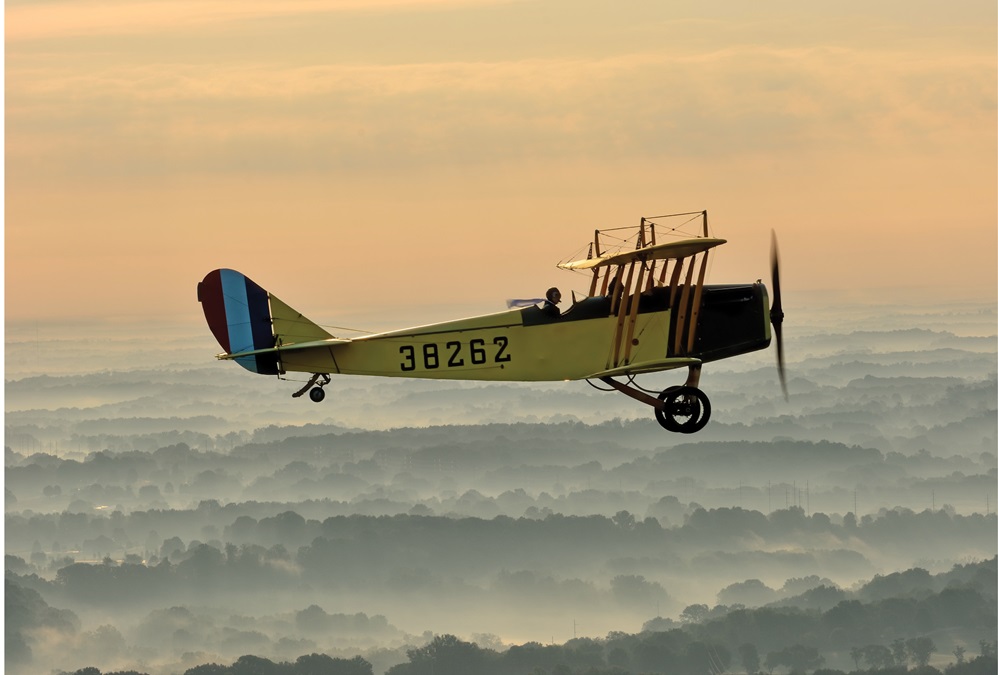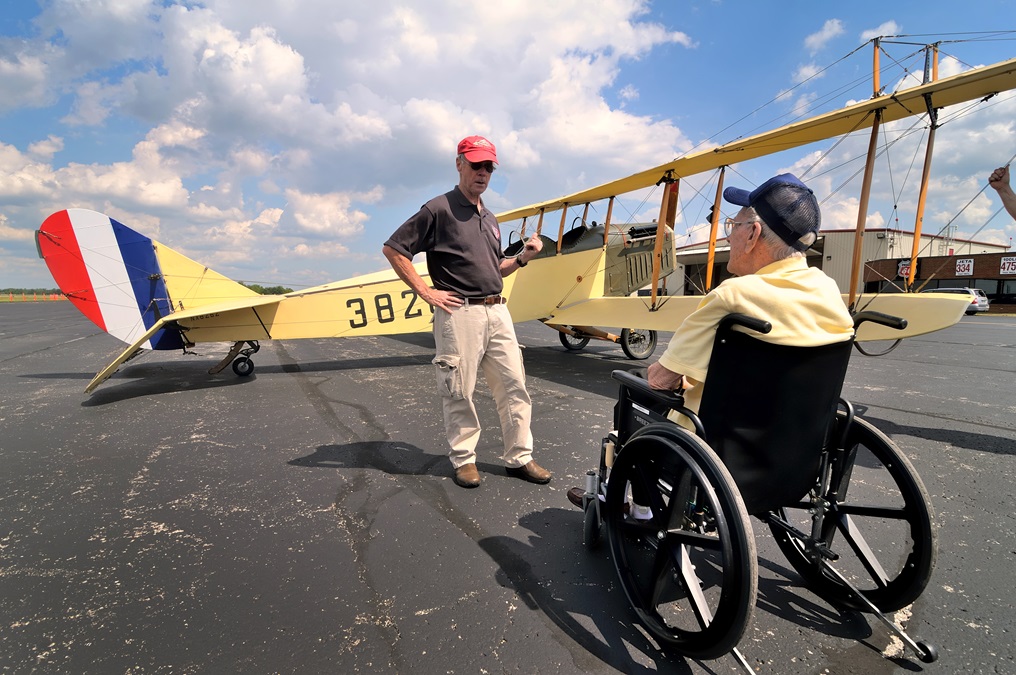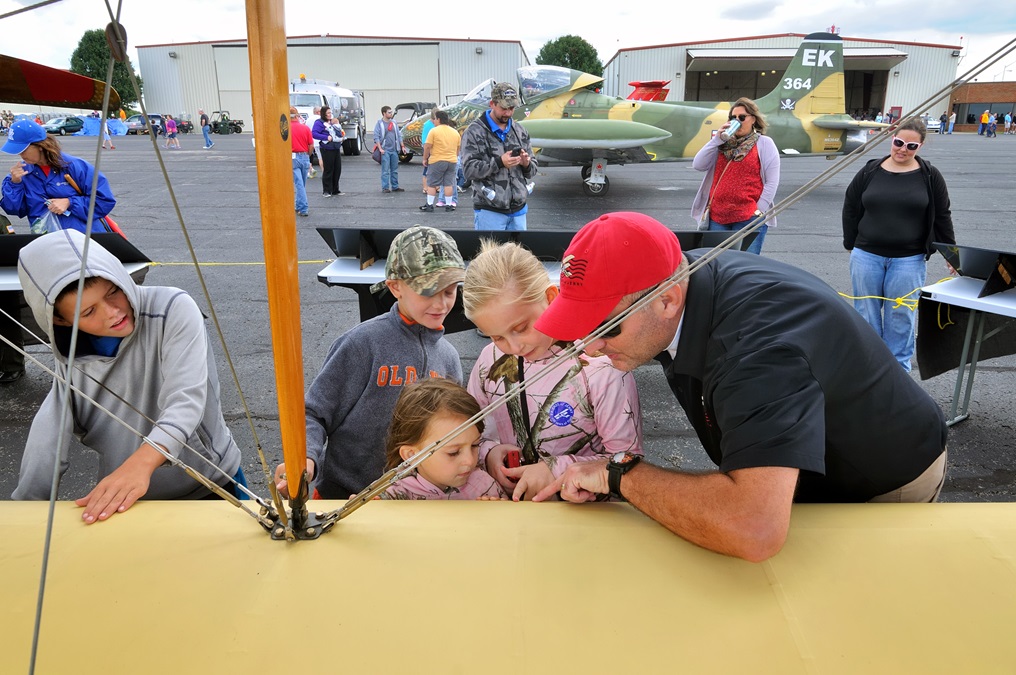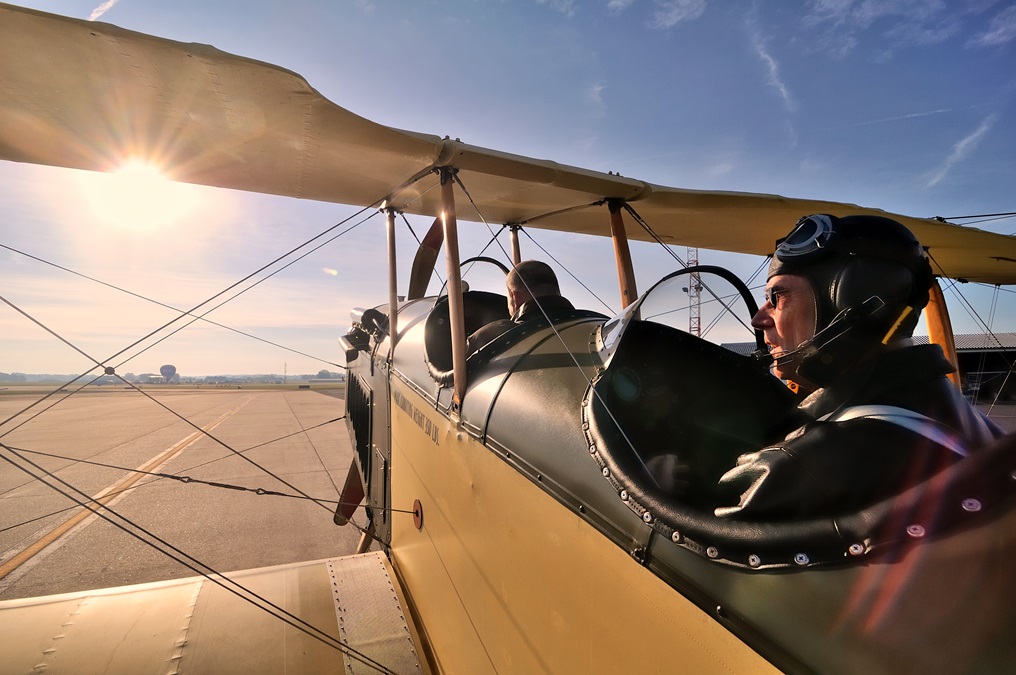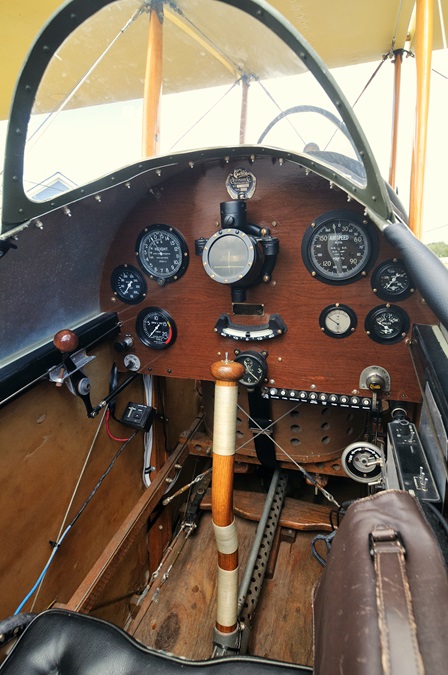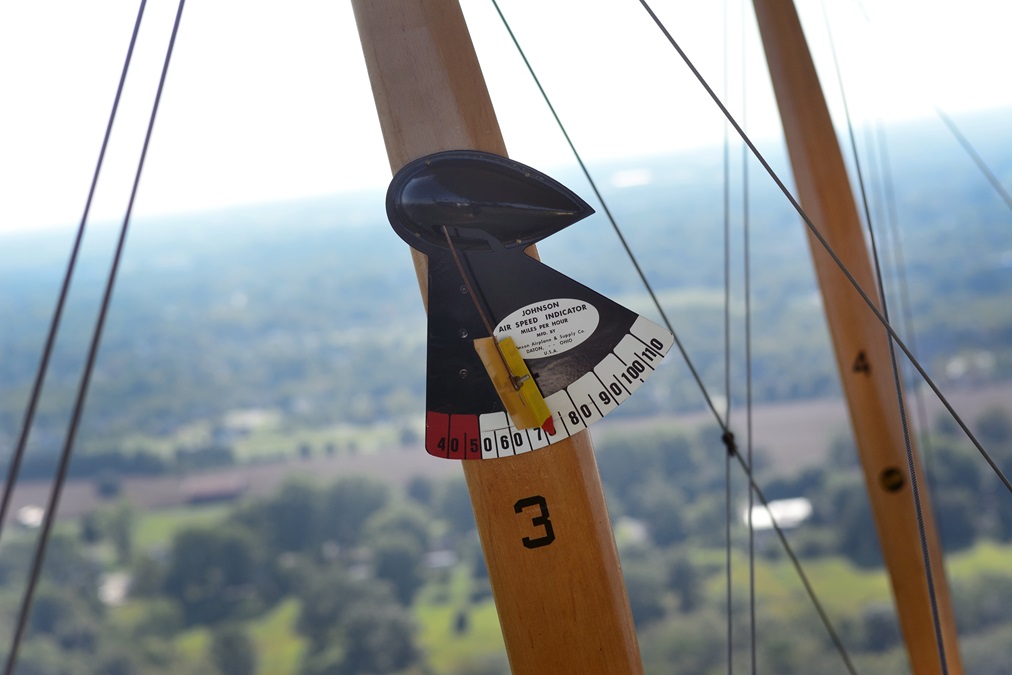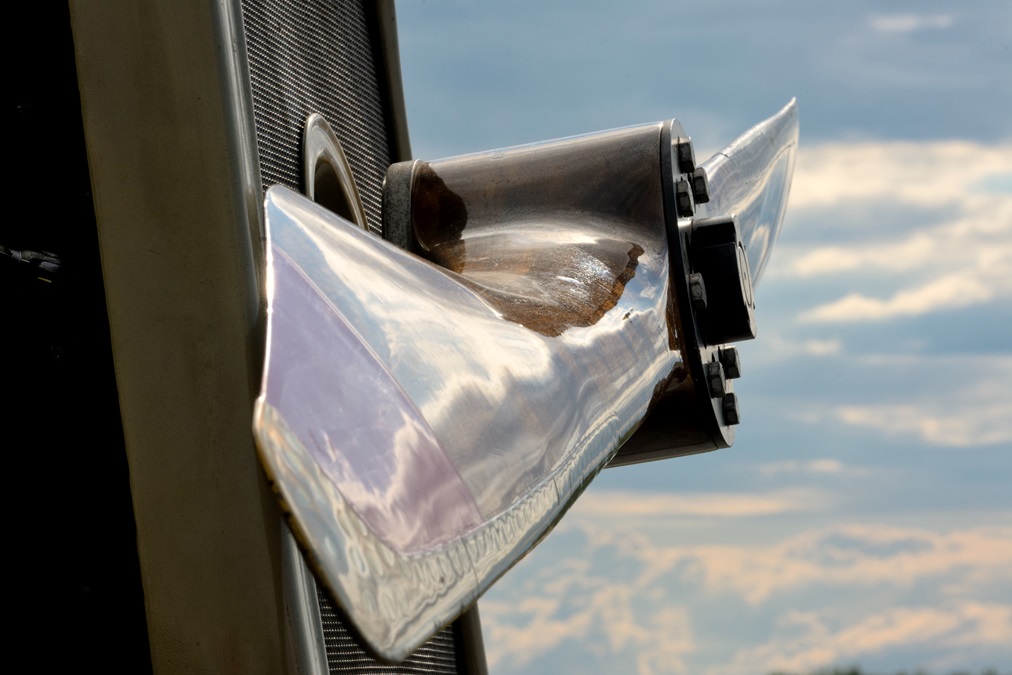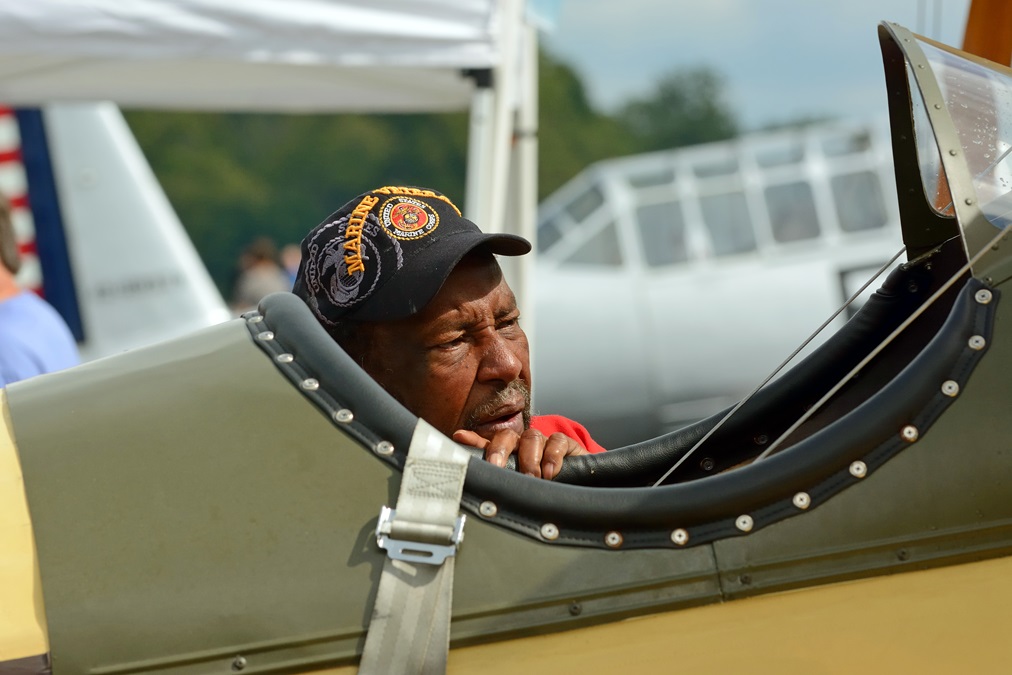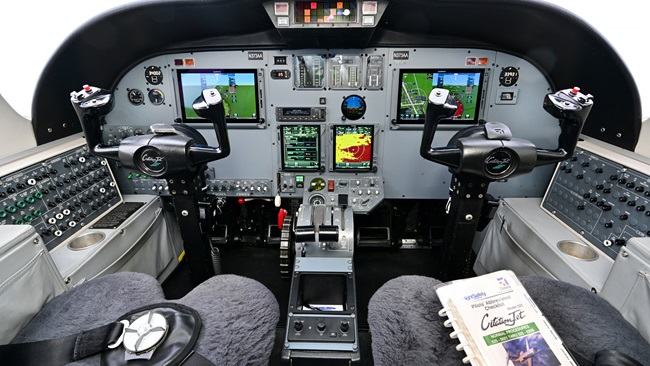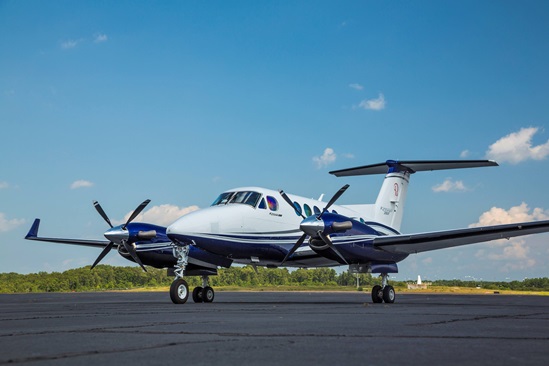Flying Miss Jenny
Sharing the history of a 100-year-old design
“Miss Jenny is a handful. She’s a very demanding lady,” laughed Dorian Walker, chairman of the organization that operates the replica and one of four pilots qualified in the airplane. The Jenny has no dynamic stability, so there’s no natural return to straight-and-level flight—it’s all hands-on, all the time. “We’ve become so accustomed to all the incredible innovations that have come from her, basically,” Walker said.
Ailerons, a tail-mounted rudder and elevator, and tractor engines were novel when the Jenny was designed, Walker explained. “That’s 100 years ago, by the way. One hundred years ago. If someone could get up in the air for five minutes, or two minutes, that was amazing.
“Miss Jenny, as we call her, captivates us all, and makes us very, very much aware of the fact that we are mere mortals that occasionally she’s going to let fly her to where we want to go,” he said. “She’s a joy and a challenge to fly.”
Most flights begin early in the morning for the calm, still air—and, Walker adds, for the romanticism of a dawn patrol. “Flying the Jenny is like sitting on top of a cork in a rough sea. Those big wings take every upward current,” he said.
With 24 gallons of fuel, endurance at 65 mph is a little more than two hours. But after an hour you’re probably ready to land, said Walker, who has logged more than 200 of his nearly 1,000 flight hours in the Jenny. Tailwheel proficiency is mandatory. Other pilots compare flying the nearly 2,000-pound Jenny to a very heavy, hands-on Piper Cub.
In September 2015, Walker flew the airplane on a typical trip: 67 nautical miles northwest from the airplane’s Bowling Green, Kentucky, base to a fuel stop at Samuels Field in Bardstown. Another 56 nautical miles took him to Georgetown (Kentucky) Scott County Airport-Marshal Field. An early departure had him on the ground there by about 12:30 p.m., just as winds were increasing and in plenty of time for the following day’s Airfest 2015.
Restoring Jenny
“It was a hulk. It was just some pieces of wood,” Walker said of the Jenny when the local newspaper wrote a short article about the project. “That opened the door to some of the most talented, most innovative, hard-working people I’ve been blessed to know in my life. It’s been absolutely amazing. When I realized the story of this airplane meant so much to so many other people, the light bulb went on.” Friends of Jenny was established as a 501(c)(3) nonprofit to oversee the reconstruction and, today, its operation.
Walker, a filmmaker, found the airframe in 2011 while working on a documentary about Glenn Curtiss. A builder had worked on the aircraft for 20 years, and it looked great—but it failed its FAA inspection. Walker took on the project, expecting to make a few corrections, but comparisons to original Jenny drawings revealed more problems. In the end, a completely new replica was built, using only a few parts from the original.
Construction took place from June 2012 to October 2013. The fuselage was constructed in Bowling Green, while the wings were built in Fall Creek, Tennessee. All fabric work, metal work, the assembly, and rigging were completed in Tompkinsville, Kentucky—where much of the work was done by Jon Foote’s A&P students, with assistance from his aviation class at Monroe County High School.
Several concessions were made for cross-country operation in the twenty-first century. Instead of restoring an original JN–4H’s Hispano-Suiza engine, a water-cooled GMC V-8 with similar weight and torque was chosen; a 2:1 reduction gear provides 1,250 rpm at cruise power. “The folks that use the original engines fly their Jennies around their airstrips, because they’re not known to be reliable engines,” Walker said. Brakes were added to facilitate operations on paved runways, as well as a removable tailwheel. The airplane has a com radio and electric pitch trim.
Behind Jenny
Walker’s always had a great interest in history, and in aviation. That combination took him to one of two topics: the Wright brothers or Glenn Curtiss. “Given the two—no disrespect to the Wrights—I love what Glenn Curtiss did. And he helped bring aviation into the aviation we know today.”
And Walker is captivated by the Jenny. “This particular biplane was so instrumental in the history of American aviation, because it did so many things. What other plane in American aviation history carried as much load, or as many benchmarks, as this airplane? The first airplane to be mass manufactured. The first airplane to serve an entire nation as a military trainer. The first airplane to carry the U.S. Air Mail on a regular and recurring basis. And really, as a barnstorming airplane—a surplus airplane after the war—the first to introduce the concept of aviation to the common, everyday American. So I’m definitely in love with the Jenny.”
With the Jenny, “we can give the gift of that history to anyone who’s willing to cast their gaze skyward,” he said—instead of freezing it in time as a museum artifact.
The airplane has flown to 11 states so far. “You don’t fly over a shopping center or a farm that someone doesn’t get in their car and follow it,” he added. “It’s not something people get to see very often.” Just nine are flyable in the United States, he said. “Only ours gets away from the airfield.”
Although the Jenny was built for two—an instructor and a student—it requires a cadre of people to operate, Walker said. A crew chief and at least one ground handler follow along in the chase vehicle, a truck equipped with tools and spare parts. It also carries six 8-foot-long display boards that are arranged around the airplane at shows, and tell the story of early aviation and the Curtiss Jenny.
One of the Jenny’s crew chiefs, Myron Callaham, a retired electrical engineer, was invited to participate at a meeting of his EAA chapter. “I went over there to the hangar, and I’ve been going back ever since,” he said. “The most appealing part, without a doubt, has been the friendships. We all love airplanes, obviously. I like the problem solving—you run into things that need to be thought through.”
Callaham also learned that he would not like to be a professional rib stitcher. “That’s far too tedious for me, but I’m glad I got to do some of it.”
Chuck Coppinger isn’t retired and couldn’t help on weekdays, but he can help with weekend travel. “I’ve always had the love of aviation,” Coppinger said. “What better opportunity than standing next to a living, breathing piece of history? These guys are a joy to be around. You can tell their passion and their love for sharing their experiences. Dorian is just eaten up with Jenny—you just have to see the glow in his eye when he talks about the history of the aircraft.”
Walker’s wife, Elaine, was drawn into the Jenny story while he was working on the Curtiss documentary. “I enjoy seeing the kids, and hearing the stories,” she said. “It’s so much fun to hear the stories.”
Stories like that of Jared Cummings, whom the crew met at the Georgetown airshow. The Air Force Reserve captain and United pilot from Buffalo, New York, said his great-grandmother was married to Glenn Curtiss.
“It’s truly an incredible team experience,” Walker said. “All of us share that one common denominator, that this airplane, this story, this salute to the aviation past, is worth the time, effort, and finances required in keeping this thing in the air and visiting America.
“It’s a privilege to fly her. I get to sit in that cockpit, and as I push the throttle forward, I can’t help but think back to Charles Lindbergh, who learned to fly in this. Amelia Earhart. Jimmy Doolittle. And it is such a rare privilege to be in that position and experience, literally, what they did.”
Email [email protected]
Expanding the mission?
Friends of Jenny has located what it believes is the only surviving DH–4 airframe remaining in its original, as-delivered-to-the-military configuration. Geoffrey de Havilland designed the D.H.4, a two-place, open-cockpit, wood-and-fabric biplane. The prototype made its first flight in August 1916.
When the United States entered World War I in 1917, it had no air force, and the design was produced by several American manufacturers as the DH–4 Liberty Plane—powered by the 1,649-cubic-inch, water-cooled Liberty L-12 engine, a 400-horsepower V-12 built primarily by Ford. Nearly 9,500 DH–4s were built in America, and nearly 2,000 reached France during World War I.
Most of the remainder were modified after the war, when the Liberty Plane enabled the first transcontinental air mail routes. Friends of Jenny wants to acquire and restore the DH–4 in time to celebrate the World War I centennial in 2017-2018; it would tour with the Jenny. At press time a Kickstarter campaign to fund the project was under way, with the goal of raising $60,000 by June 8. More information is available on the website. —MPC

